SmartBees Newsletter 1, July 2015
This is the first of a series of biannual newsletters from the SmartBees project. In this newsletter, we will give a short summary of the project and aims of the different working groups. In addition we also describe in more detail, two of the on-going tasks.
The SmartBees project
SmartBees aims to analyse the current level of genetic diversity among Europe's bees and hope to increase it using appropriate methods. The participating scientists will also seek to understand the critical interactions between Honey bees, the Varroa mite, and viruses; in order to identify which mechanisms allow otherwise innocuous viruses to become so dangerous in combination with the mites. The reasons for differences in bees' resistance capabilities will also be investigated using the most modern molecular biology methods. Breeding strategies that have proven to be very successful will be adapted for use in honey bee races that until now have been neglected. These techniques will allow these previously unexploited races to be adapted and enhanced to suit the needs of local beekeepers and enable their preservation through their utilization. Data from the European Reference Laboratory for Bee Diseases will be analysed in order to prepare for diseases and threats that are not currently problematic, but may become an issue in the future. One group within the project specializes in knowledge transfer, and is dedicated to preparing the project findings for practical use, creating teaching modules and building information networks within, and between countries. These directly involve beekeepers in order to create sustainable improvements in bee health and genetic diversity.
Smartbees is a large collaborative project, with 16 partners from 11 countries and is funded through the European Commission. Find more about the SmartBees partners here.
Structure of SmartBees and description of working groups
The project’s work is divided into 10 separate work packages. Work packages (WP) which share common objectives are grouped into so-called working groups (WG); Biodiversity (WP3, 4), Extension (WP 5, 6, 7), Breeding (WP 1, 2), Pathogens (WP 8, 9). An overview of these work packages is depicted in figure 1.
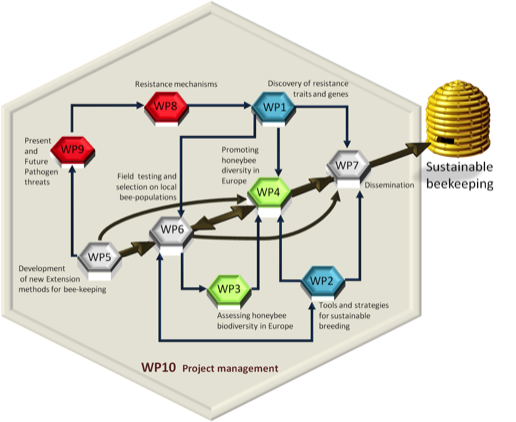
Figure 1. Work packages, their connections and organization into working groups.
WG Biodiversity
The biodiversity and conservation workgroup includes WP3 (Assessing honey bee diversity in Europe) and WP4 (Promoting honey bee diversity in Europe). The working group is chaired by Per Kryger (AU, Denmark).
WP3 (chaired by Marina Meixner at LLH, Germany) will describe the current genetic diversity present in honey bees across Europe, both in relation to threats to, and possibilities for, the European subspecies. We aim to develop a novel system for subspecies classification by linking genomic data with historic descriptions based on morphological features. This approach will provide a new and complete baseline for the future conservation of genetic diversity in honeybees throughout Europe, and beyond. The aim is to provide a reference manual and dataset for the fast and unambiguous identification of subspecies composition of an individual bee, offering a major breakthrough for honeybee conservation. Contributing partners in WP3 are AU, AUA, EHU, LLH and GenSk.
The focus of WP4 (chaired by per Per Kryger at AU, Denmark) is on conservation in relation to different subspecies of honey bees. Starting with systematic research on beekeepers’ motives for choosing a particular source and type of queen, we aim to understand beekeepers’ attitudes towards local bees in order to aid in conserving the diversity within, and between, subspecies in Europe (see below for a more detailed description of the on-going survey to achieve this understanding). We will also establish a network of European bee conservation initiatives and link them with the testing and breeding activities of the SmartBees apiary network (WP6) to promote in situ conservation efforts. Contributing partners in WP4 are AU, AUA, EHU, LLH and GenSk.
WG Breeding
The breeding group focuses on 3 aims:
- To measure the expression of known Varroa resistance traits in various European subspecies, and look for new ones
- Participate in the creation of a DNA-chip for fast and easy measurement of hygienic behaviour to be used by breeders
- Adapt methods for calculations of breeding values (online) for each European subspecies. This includes the translation of the user interface of the online database beebreed.eu, into various languages, and modelling breeding strategies for each region.
WG Pathogens
The Pathogen Group focuses on:
- Investigating the underlying mechanisms that determine the resistance and tolerance of the honey bees to Varroa and deformed wing virus (DWV)
- Determining both the present and future threats from DWV, the most important viral disease of honey bees in Europe.
WP9 (chaired by Richard Thiery, ANSES): We aim to understand how the normally non-pathogenic DWV becomes highly pathogenic when the honey bee colony has Varroa. What happens to DWV as it is passed between the bee and the Varroa and then transmits back to the bee that causes it to become so damaging? If we understand the change in DWV in the presence of Varroa, we will be better able to predict and control DWV damage. We will also survey across Europe DWV variants that have varying degrees of pathogenicity and are present in different honey bee subspecies to help understand and predict DWV outbreaks. Contributing partners in WP9 are LIB, ANSES, AU, FERA, UNIABDN, UNINA and UNIUD.
WG Extension
The Extension working group includes WP 5 (Development of new extension methods for beekeeping), WP 6 (Field testing and selection of local bee populations), and WP 7 (Dissemination) and is specifically focused on interacting with the beekeeping society. In addition to these three work packages, work package 4 (Promoting honey bee diversity in Europe) constitutes a central part of the project and reflects SmartBees deep commitment to sustainability, through direct involvement of the beekeeping community we work towards the goal of a sustainable future for the European honey bee populations. This Extension working group is chaired by Magnus Ljung (SLU).
WP 5 (chaired by Magnus Ljung at SLU (Sweden)) will identify the current knowledge gaps across Europe, describe regional Knowledge and Innovation Systems in the beekeeping sector, and develop a tool-box for advisory services in apiculture and development extension. Through these activities SmartBees will develop and suggest regionally adapted strategies for knowledge development, involving both beekeepers and breeders (incl. performance testing, interpretation of results of genetic evaluation, region-specific Varroa management strategies). See below for a more detailed description of the ongoing survey of beekeepers. Contributing partners in WP 5 are SLU, EHU, FERA, ICDA, IO, LLH, and NBA.
WP 6 (chaired by Ralph Büchler (LLH)) will initiate beekeepers into stock improvement by establishing and supporting selective breeding across all European bee subspecies. This work requires training of beekeepers that will be engaged in performance testing and disease resistance testing of local honey bee populations (see a more detailed description of this ongoing activity below). SmartBees aims to build networks for selective breeding of the neglected European subspecies that should aim to be self-supportive, continuing after the project finishes. Contributing partners in WP 6 are LLH, ANSES, EHU, FERA, ICDA, IO, NBA and UNIUD.
WP 7 (chaired by Bjørn Dahle (NBA)) will disseminate project results to the different user groups. With input from WP 5, SmartBees’ dissemination will be adapted and targeted to achieve cost- effective transfer of knowledge and implementation of new strategies, tools and technologies which are crucial to achieve the desired impact of the project to all stakeholders. Contributing partners in WP 7 are NBA, ANSES, AU, AUA, CT, EHU, FERA, ICDA, IO, LLH, and UNIUD.
The new dissemination strategies and extension tools for Bee-keepers needs
One of the aims of SmartBees is to suggest new and regionally adapted extension methods for sustainable management of honey bee populations. WP5 is responsible for this aim of the project. However, to be able to achieve this aim we first need to know something about the different information sources and channels beekeepers and breeders of honey bees use. This information is being gathered through a pan-European survey.
The objectives of this sub-task is twofold; to create a better understanding of existing knowledge gaps, and secondly to investigate what extension methods are in use today and what beekeepers and breeders might prefer in the future. It is important to get some base-line data on the diversity and regional needs of dissemination strategies and extension tools in Europe today. To our knowledge this has not been done previously.
The data will be obtained mainly through an on-line survey. Each survey is translated to the respective language of each member state of Europe. So far the survey has been translated into eight European languages. This has been done with essential and helpful support from the whole consortium and our regional partners. The survey will be further translated and spread this summer. In our research proposal we aimed to deliver the survey to a broad sample of beekeepers in six distinct regions of Europe (as defined by WP7 and the apiaries network), but we have since broadened our ambitions, and will now try to cover most of the strong honey-production regions in Europe.
In SmartBees we have chosen to combine the need to survey bee-keepers in WP5 (developing new extension methods) and WP4 (promoting honey bee diversity in Europe) into the one on-line survey. The consequence being that the survey is quite long, but our preliminary findings show that this seems not to have affected the response rate in different regions. The differences we have seen so far are more related to access to and experience of on-line surveys or the ability to reach out and motivate bee-keepers to answer.
The information generated will of course support the future development of WP5 and the aim to identify relevant and regionally adapted extension methods and tools. But the result of the survey will also be beneficial for other WPs, for disseminating their results.
At the beginning of this autumn the results will be analysed and synthesised in a report, where the European level, as well as regional differences, will be presented and discussed.
The second part of the questionnaire is designed to help the SmartBees team to target future communication strategies for beekeepers. We believe that science cannot succeed in solving the problems of beekeepers alone; there is a need for close cooperation. Likewise beekeeping cannot solve its problems without scientific support. In the past these two groups have often failed to find effective means of communication. To address these shortcomings SmartBees will research the preferred methods of learning by beekeepers and therefore establish common ground for beekeepers and scientists to meet and exchange information, enabling knowledge to grow in both camps.
In view of the options available through the use of modern technology, evaluating the preferred means of knowledge transfer is particular important. There is little sense in trying to address beekeepers by means that are either out-dated, or for which they are not yet prepared. Similarly, science needs to gather information quickly and reliable from the field observations of many beekeepers across Europe. Here, new technology offers attractive options if it is implemented according to the interest level of beekeepers. You can help form the future means of communication by spending 10 minutes on the questionnaire which is already open. Enter the questionnaire here.
Training activities for initiating European wide honey bee breeding
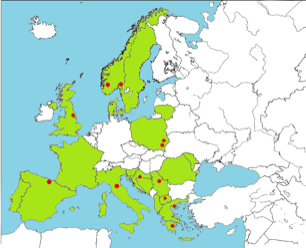
Based on the wealth of experience in breeding activities in Germany (Arbeitsgemeinschaft Toleranzzucht, breeding association) and other similar regional initiatives we developed a tailor-made training model. These include training through theoretical presentations and practical in-field demonstrations of the newly developed breeding and selection methods (Fig. 2 - 7). These were combined with dynamic exchange of ideas and constructive debates about the ways methods can be adjusted to suit the diversity of different European environmental conditions and beekeeping practices. Through these interactions we ensure the requirements for usage of unique BEEBREED data are achieved. This data provides a base for estimation of breeding values whilst meeting the requirements for the local practices of beekeepers’ for the best colony management. The training events were implemented by the expertise of Dr. Aleksandar Uzunov and Dr. Ralph Büchler from the Bee institute in Kirchhain (Germany), who were supported by local partner institutes to allow any adjustment of testing methods to suit the various European local conditions.
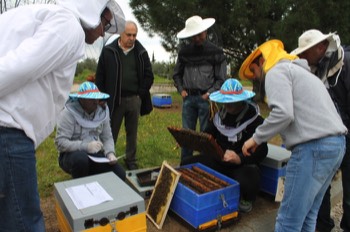
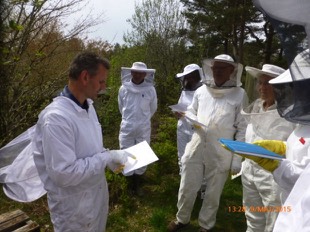
Demonstration of method for estimation of colony size (Nea Moudania, Greece)
Description of recordkeeping card (Bergen, Norway)
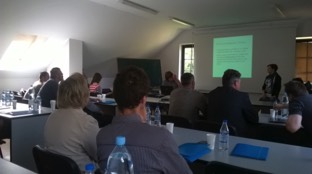
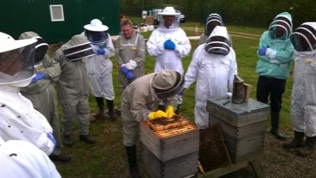
Presentation of breeding activities in Poland and Lithuania (Pulawy, Poland)
Breeders are practicing pin test method in York (UK)
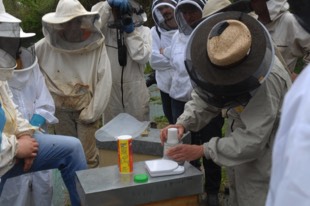
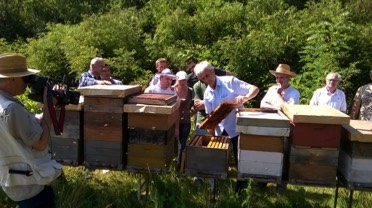
Training for use of powdered sugar method in San Sebastian (Spain)
Assessment of colony’s defensive behaviour by breeders in Sisak (Croatia)
Our main partners are the beekeepers and breeders; from Scandinavia to distant Mediterranean islands, and from British Isles to Baltic counties, all of which have already provided valuable suggestions for adjustment of the methods for performance testing of the breeding colonies. In this way they are contributing to the development of the “Performance testing protocol”, including the protocol sheets with detailed description of the methods for colony management and testing. These protocols are now available online on our website in 11 European languages, in a downloadable free booklet, providing all the necessary information for beekeepers and breeders in order to insure proper implementation of the testing procedure. We believe that using this approach we can work closely with as many beekeepers as possible around Europe who are keen to promote and protect their local honey bee populations.
In summary, our aim is to support regional activities for the genetic improvement of local honey bee populations, concerning both their overall performance, and especially their resistance to Varroa destructor. We aim therefore to stay focused on ongoing development of our concept and expansion of a breeding network across regional and local initiatives, in order to reach sustainable breeding and conservation of diverse European honey bee populations.
Future events
Members of the SmartBees consortium plan to participate at the following events:
- 16th Panhellenic Entomological Congress, Heraklion - Crete-Greece, October 20-23, 2015 - on the web
- Conference of the Federation of Greek Beekeepers' Associations, Athens, December 2015
